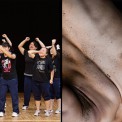Festival/Tokyo 2014 is now over. Thank you to all our audiences and visitors.
-
11.30.2014
04.06.2015
/ Information for Overseas Audiences / Program
Sachio Ichimura (Director, Festival/Tokyo): Festival/Tokyo at Festival Bo:m
The F/T Director’s text marking the participation in Festival Bo:m in Korea
This spring Festival/Tokyo is presenting two of its productions from last year’s festival at Festival Bo:m 2015 in Korea.
Read more about F/T’s productions at Festival Bo:m: Festival/Tokyo in Seoul
Festival/Tokyo at Festival Bo:m
I first wish to offer my heartfelt thanks to Festival Bo:m for giving Festival/Tokyo this great privilege. I have always taken a high interest in the Festival Bo:m programming every year. Astonished and amazed at the new art movements emerging in Korea, especially dawon arts, Festival/Tokyo 2014 programmed a special showcase of dawon. This would never have been possible without the cooperation of Festival Bo:m’s Artistic Director, Seunghyo Lee, and I would like to take this point to express my gratitude to him.
I would like to introduce two characteristic works from Festival/Tokyo. There were two key distinctive features about the Festival/Tokyo 2014 program. The first was the series of artistic collaborations that took place between artists from the performing arts and artists from the visual arts and other fields. Multiple artists from different fields came together to create work collaboratively. From the audience’s point of view, “Mr. Creature” is both a dance work and also a visual artwork. While modern art tended to be created by artists who worked alone, I think that in today’s world, with its emphasis on diversity, it is more appropriate to create work out of communication between several artists with different values. Of course, this comes from my strong awareness of dawon. “Mr. Creature” was a work that took a gamble, where two artists from different fields created something together and transcended the boundaries between genre and fields. As such, it wasn’t a case of a choreographer simply commissioning a visual artist to make a stage design; the pair collaborated on the creation of the work from the initial concept. It was a very risky adventure but the results were more than I could have imagined. Festival/Tokyo 2014 featured four works made in this kind of style and out of the four I decided to present “Mr. Creature” at Festival Bo:m. The choreographer and dancer Hirokazu Morikawa studied mime and circus arts in France and is one of Japan’s leading dance artists today. His collaborator, Itaru Sugiyama, works widely as a stage designer, including both theatre and dance, and has won the prestigious Yomiuri Theatre Award.
The other distinctive feature is related to the earthquake, tsunami and subsequent nuclear power plant accident that occurred in March 2011, mainly in the Tohoku region of northeast Tokyo. We have previously presented works created based on questions of directionality: How to accept this disaster and then turn it into a work of theatre? But at Festival/Tokyo 2014 we presented works born out of close personal experiences of the catastrophe. Usually people set the limits of their capabilities without knowing it, and it is then difficult to overcome them. But when people are placed into an abnormal and cruel situation they have never experienced, it becomes possible to manifest abilities that go way beyond the boundaries that you had thought had been your limits. These people can then open up a new world. This is a kind of miracle, though in fact it is something we are all originally capable of doing.
“Moshi-ita – What if the manager of a high school baseball team called in an Aomori itako shaman?”, the second F/T production appearing in Festival Bo:m, is one such work. All the performers are high school students from Aomori Prefecture, which is located in Tohoku. The play is written and directed by Seigo Hatasawa, who is a high school teacher and also a playwright and director quite well known in Japan. The play has been performed many times to audiences living in temporary housing after evacuating from their homes due to the Tohoku disaster. The theme is about how surviving high school students should live their lives after the tsunami. With its completely bare stage, fast-paced anti-realist acting, and set-up of an itako (medium) speaking to the dead, it was one of the most acclaimed productions at F/T14. It has been broadcast in its entirety on NHK, the Japanese state television broadcaster, and featured many times in the media. Even looking back at Japanese theatre history, there has never been a high school play as acclaimed as this. The performance in Korea will be on April 18th, which is directly after the one-year anniversary of the MV Sewol disaster, and I believe, in the same way as for Tohoku, it could be interpreted as a work intended for the living and as a requiem for the dead. In Japan too there has been almost no resolution for the people who suffered in the disaster or for the Fukushima incident.
We will also introduce other Festival/Tokyo productions through video screenings, and anticipate our participation in Festival Bo:m will become an important node for longer initiatives in order to build better relationships with our peers working in the arts in Seoul. We are determined to make every effort we can. In closing I would like to say that I foresee decades from now when we look back on the past, this project in 2015 will have changed the history of cultural exchange.
Director, Festival/Tokyo
The original Japanese of this statement and a Korean translation have also been published on the Festival Bo:m website.


























